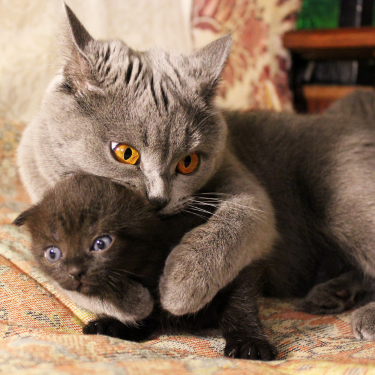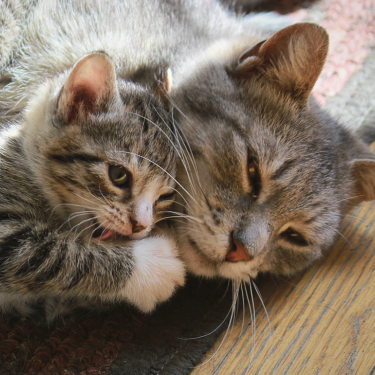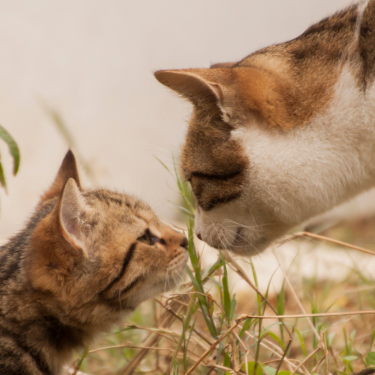How to Introduce a Kitten to a Cat - Kitten Integration
Are you planning to introduce a cuddly new bundle of fluff to your older, wiser cat? Before making any introductions, there are a few things to consider. Cats can be territorial and may not immediately welcome a new and unfamiliar cat into their environment.

Fortunately, there are steps you can take to reduce stress and make the introductions more enjoyable! Here's how to introduce a kitten to a cat.
Should I Get Another Cat or Kitten?
Like their wild ancestors, cats typically prefer solitary living. While some resident cats may get along well with a new cat or enjoy the company of their littermates, a cat accustomed to being alone might not appreciate the addition of a new kitten in the house.
Before you bring a new kitten or cat home, consider whether this decision is truly in the best interest of your existing cat(s). If you think your old cat is lonely, it’s likely that all they want is a bit of playtime and attention from you.

If you want to learn how to introduce a kitten to a cat, it’s important to follow a careful introduction process. Keep the new and existing cats separate initially. Use a baby gate and provide separate food bowls and litter boxes. Gradually allow them to spend time near each other, creating positive associations with treats and play.
If your resident cat hisses or seems upset, give them more time apart before trying again. When you finally bring the kitten and the cat face to face, supervise closely to ensure a smooth transition. By taking these steps, you can help your cats feel more comfortable and reduce stress during the introduction process.
How to Introduce a New Kitten to a Cat.
Regardless of how good natured your resident cat is, they are instinctively territorial and aware of their place in a strict social hierarchy. Introducing a new kitten into their environment can potentially trigger various negative reactions. Your cat may feel jealous because the newcomer is suddenly getting all the attention, uncomfortable due to the disruption of their preferred cleanliness in their litter box, and aggressive or moody because an energetic youngster is constantly invading their space.
When you bring a new kitten or cat home, it's essential to consider your existing cat's feelings. Use a baby gate to keep them separate initially and provide separate food bowls and litter boxes for each cat. This careful introduction process helps build positive associations. Allow the cats to spend time near each other gradually, and if your resident cat hisses or shows discomfort, give them more time apart.

Bringing the new kitten and existing cat face to face should be done slowly and under supervision. With a little forward planning, thoughtful psychology, and consideration, you can make the introduction process relatively stress free. This helps create a solid foundation for the kind of friendship and companionship that makes having a 'two-cat family' so delightful.
How to Introduce a Kitten to an Older Cat.
Friendly, single adult cats can struggle with adjusting to a new kitten. Often, an old cat may appear sad, reclusive, hiss frequently, and sometimes stop eating or start urinating in unusual places if they aren't adapting well to the new cat in the home.
These behaviours occur because cats dislike change, especially when it disrupts their established territory. Introducing a kitten to an adult cat can cause significant stress in your household, but there are steps you can take to make the introduction process smoother.

Preparation is key to successfully introducing a new kitten to your resident cat. If you prepare your existing cat for the new arrival and make the changes seem less drastic, they are more likely to adapt to their new roommate. Set up a kitten safe room and gradually introduce the cats to each other. Use a baby gate to keep them separate initially, and provide separate food bowls and litter boxes. Allow the cats to spend time near each other to build positive associations.
When you bring the new kitten home, take it slow. If your resident cat hisses or seems uncomfortable, give them more time apart. When you finally bring the kitten and the cat face to face, supervise closely. By planning ahead and considering your cats' feelings, you can help everyone adjust to the new dynamic, making it more likely for your cats to become friends and enjoy living together.
Be sure to give yourself plenty of time to prepare for this adjustment with these steps.
Preparation.
Calm Your Older Cat
Pheromones are a helpful tool for creating a calm environment for any cat, whether old or new. The weeks leading up to the arrival of a new kitten present an opportune time to make use of them. Diffusers, sprays, and wipes are all readily available options that can help your cat feel relaxed without the need for medication. Consider incorporating pheromones into your routine at least a few weeks before bringing home a kitten.
If you anticipate that your existing cat may struggle with the presence of a new kitten, it's worth considering nutritional supplements designed to promote feline calmness. These supplements do not sedate your pet but rather support them in remaining composed and relaxed. They are most effective when administered several weeks before the anticipated stressful event and can be continued after the new kitten arrives. Ingredients commonly include L-theanine, Philodendron, magnolia, whey or milk proteins, and other natural compounds proven to be safe and effective for pets.

Consulting with your veterinarian is crucial when selecting safe and effective calming supplements. With the plethora of "calming products" available today, it's essential to seek their guidance before starting your pet on any supplement regimen. This ensures that the chosen supplement aligns with your cat's needs and provides the best possible outcome for their well-being and adjustment to the new addition to your home.
Additionally, consider following proper steps for How to Introduce a Kitten to a Cat to facilitate a smooth transition and foster positive interactions between them.
Get Your Home Ready
Before bringing your new kitten home, it's crucial to prepare the environment with items specifically tailored to their needs. This includes food bowls, beds, an additional litter box, and toys. Start strategically placing these items around your home about a week prior to the kitten's arrival. This allows your existing cat to become familiar with the new scents and objects. Whenever possible, incorporate items that already carry the scent of the kitten. Ensuring readiness for the new addition is crucial; your older cat can sense stress and unpreparedness, which may adversely affect them.
To facilitate a smooth transition, designate a small, secluded room such as a bathroom as a safe space for your new kitten during their initial week at home. This room should allow your older cat to hear and smell the kitten but prevent direct interaction. Place the kitten's essentials, like a litter box and food bowls, in this room, along with a toy that belongs to your older cat.

Cats can experience stress when resources are limited. Essential resources include food, water, litter boxes, prime perching spots, and your attention. Ensure there is a litter box for each cat plus an extra, distributed strategically throughout the house to minimize territorial disputes. Cats prefer not to cross paths with each other when accessing resources, so consider this when arranging them.
It's advisable to begin using pheromones and calming supplements before making any household changes, as transitions alone can induce stress related illnesses in cats. Lastly, follow proper steps to introduce your kitten to your existing cat gradually. This process helps establish positive interactions and minimize potential conflicts between them.
Prepare Your Older Cat
Before introducing a new kitten to your resident cat, ensure the health of your older feline companion. Added stress to an unhealthy cat can exacerbate existing issues, so it's essential for your cat to be mentally and physically prepared for the new addition. Schedule a checkup with your vet to confirm your cat's health status and ensure their vaccinations, including the rabies vaccine, are up to date. Since respiratory diseases are common in kittens, it's crucial for your older cat's immune system to be robust.
Knowing the Feline Leukemia (FeLV) and Feline Immunodeficiency Virus (FIV) status of both your cat and the new kitten is also important prior to introduction. Your veterinarian can provide guidance on the recommended testing that should take place before bringing a new cat into your home.

When introducing a new kitten to your resident cat, take it slow and follow a gradual introduction process. Start by keeping the kitten in a separate room, such as a bathroom, for a few days to allow them to acclimate to their new surroundings. During this time, let your resident cat sniff around the door and become familiar with the kitten's scent.
Once both cats seem comfortable with each other's scent, you can start allowing brief supervised interactions. Keep these interactions positive and rewarding for both cats, and be prepared to separate them if any signs of aggression or stress occur. Over time, gradually increase the duration of their interactions until they are comfortable being together unsupervised.
Taking these precautions ensures a smoother transition for both your resident cat and the new kitten, setting the stage for a harmonious relationship between them.
The Introduction
Upon bringing your new kitten home, facilitate their introduction to your resident cat gradually. Start by allowing your cat to sniff the kitten while it remains in a carrier. Escort them both directly to the designated room for the kitten, ensuring essentials like the litter box, food bowls, bed, and toys are readily available. However, refrain from immediate interaction between the new kitten and your resident cat.
During periods of absence or when you cannot supervise their interactions, confine the kitten to their designated room, especially at night. This confinement allows your resident cat to familiarize themselves with the new scent and presence of the kitten. It's common for cats to express curiosity by attempting to investigate under the door or listen closely to the sounds from the other side. Maintain this separation for approximately a week.

After interactions with the kitten, be sure to provide ample attention and support to your resident cat. This reassurance is vital as they adjust to the new addition. The scent of the kitten on your clothing can aid in familiarizing your resident cat with the newcomer. However, ensure proper hygiene by washing your hands between interactions to prevent the spread of infections.
This gradual and cautious approach helps foster a positive relationship between your resident cat and the new kitten, minimizing the likelihood of conflicts or aggressive behaviors. These steps outlined above can facilitate a smooth introduction process of a kitten to a cat, adhering to the guidelines on How to Introduce a Kitten to a Cat.
Encourage Time Together
After about a week, allow your new kitten to explore the house under your watchful eye, ensuring your resident cat observes this exploration. Let your resident cat retreat if it feels the need; avoid forcing interaction between them. If your cat enjoys interactive toys like a feather wand or laser pointer, consider playing with both cats simultaneously. This encourages mutual activity and bonding. You can also offer treats to both cats at the same time and feed them from separate bowls simultaneously, ensuring enough distance between the food bowls to prevent any feelings of threat in your resident cat.

Encourage any positive interactions your resident cat has with the kitten using praise, treats, and physical affection. It's important to associate the kitten with happy experiences for your resident cat, especially if there have been initial hisses or hesitations.
Allow Your Older Cat to Establish Boundaries
Cats naturally seek order, and the introduction of a new member to the household prompts a learning phase for everyone involved. Your resident cat may undergo a period of boundary setting with the new kitten, possibly expressing disapproval through hissing and swatting if the newcomer crosses certain lines. While this behavior is typical, it's important not to intervene as long as it remains limited to hissing and swatting. Your older cat is conveying essential lessons to the kitten about their respective boundaries within the household.
Problems and Proofing Behavior
While they may not always develop into the closest of companions, most cats eventually learn to tolerate and sometimes even appreciate the presence of another feline roommate. If initial interactions between your resident cat and the new kitten aren't smooth, don't lose hope. Older cats may require time to acclimate to a younger cat. Rushing the socialization process between cats can be a common mistake, often leading to frustration if immediate harmony isn't achieved. Stay composed and work gradually to bring the cats together, incrementally increasing their interaction time. Should your older cat exhibit particularly aggressive behavior towards the new kitten, consider seeking advice from your vet or a behavior specialist for tailored guidance.

















